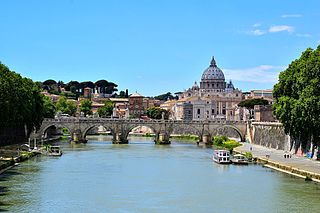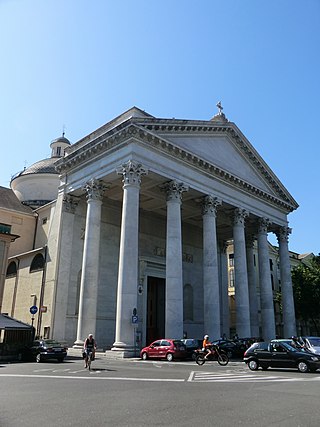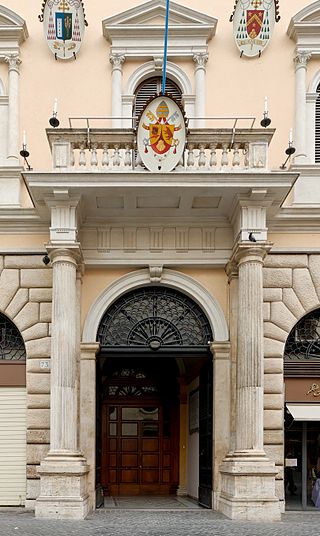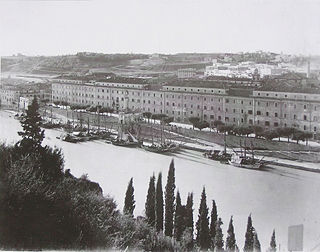
The Tiber is the third-longest river in Italy and the longest in Central Italy, rising in the Apennine Mountains in Emilia-Romagna and flowing 406 km (252 mi) through Tuscany, Umbria, and Lazio, where it is joined by the River Aniene, to the Tyrrhenian Sea, between Ostia and Fiumicino. It drains a basin estimated at 17,375 km2 (6,709 sq mi). The river has achieved lasting fame as the main watercourse of the city of Rome, which was founded on its eastern banks.

The Pontifical Croatian College of St. Jerome is a Catholic college, church and a society in the city of Rome intended for the schooling of South Slav clerics. It is named after Saint Jerome. Since the founding of the modern college in 1901, it has schooled 311 clerics from all bishoprics of Croatia.
The papal household or pontifical household, called until 1968 the Papal Court, consists of dignitaries who assist the pope in carrying out particular ceremonies of either a religious or a civil character.

The Annuario Pontificio is the annual directory of the Holy See of the Catholic Church. It lists the popes in chronological order and all officials of the Holy See's departments. It also provides names and contact information for all cardinals and bishops, the dioceses, the departments of the Roman Curia, the Holy See's diplomatic missions abroad, the embassies accredited to the Holy See, the headquarters of religious institutes, certain academic institutions, and other similar information. The index includes, along with all the names in the body of the book, those of all priests who have been granted the title of "Monsignor".
The Prefecture of the Papal Household is the office in charge of the Papal Household, a section of the Roman Curia that comprises the Papal Chapel and the Papal Family.

Ostia Antica is the 35th zona of Rome, Italy, four kilometers away from the coast. It is identified by the initials Z. XXXV and it is distinct from Ostia. Ostia Antica belongs to Municipio X.

The Diocese of Biella is a Roman Catholic ecclesiastical territory in northern Italy, in the Piedmont region. The diocese was established in 1772. It is a suffragan of the Archdiocese of Vercelli. Biella is a city in Piedmont, 42km northwest of Vercelli.

Carlo Luigi Morichini (1805–1879) was a Roman Cardinal.

The Diocese of Chiavari is a Roman Catholic ecclesiastical territory in Liguria, northern Italy. It was created on 3 December 1892 by Pope Leo XIII in the Bull Romani Pontifices. It is a suffragan of the Archdiocese of Genoa.

Porta Portese is an ancient city gate, located at the end of Via Portuense, where it meets Via Porta Portese, about a block from the banks of the Tiber in the southern edge of the Rione Trastevere of Rome, Italy.

The Roman Colleges, also referred to as the Pontifical Colleges in Rome, are institutions established and maintained in Rome for the education of future ecclesiastics of the Catholic Church. Traditionally many were for students of a particular nationality. The colleges are halls of residence in which the students follow the usual seminary exercises of piety, study in private, and review the subjects treated in class. In some colleges there are special courses of instruction but the regular courses in philosophy and theology are given in a few large central institutions, such as Pontifical Urbaniana University, the Pontifical Gregorian University, the Pontifical Lateran University, and the Pontifical University of Saint Thomas Aquinas, Angelicum.

Municipio I is an administrative subdivision of the municipality of Rome, encompassing the centre of the city.

Pompeo Gabrielli was an Italian general and politician, the first layman to be appointed Minister in a Papal States cabinet.

Porto di Ripa Grande was the river port of Rome, just downstream the former Pons Sublicius, where the wares, going up and down the Tiber towards the dock of Fiumicino, were handled. The building of the muraglioni has erased its existence and function, just keeping a trace in the toponymy and in the two ramps giving access to the quay of the river.

The 1859 Perugia uprising occurred on 20 June 1859, in Perugia, central Italy. The inhabitants rebelled against the temporal authority of the pope and established a provisional government, but the insurrection was bloodily suppressed by Pope Pius IX's troops.

The Pontifical Lombard Seminary of Saints Ambrose and Charles in Urbe is an ecclesiastical institution that serves as a residence for and trains diocesan priests who have been sent to Rome by their bishop to pursue an advanced degree or follow a specialized course of study at one of the pontifical universities there.

Tor San Michele, also known as Forte San Michele, is a coastal watchtower in Ostia, a frazione of the Municipality of Rome (Italy), rising near the mouth of the Tiber.
Silvio Galizia was a Swiss architect and artist. Most of his life he lived and worked in Rome, Italy.

The Screw Corvette Immacolata Concezione was one of the last ships in service with the Papal Navy, built in the English shipyards of Thames Iron Shipbuilding Co. in Blackwall. It was delivered to Civitavecchia in 1859.

















